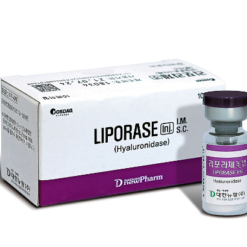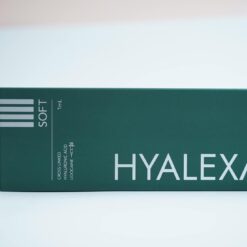Hyaluronidase Liporase
Product Information
- Formulation: Injectable powder
- Origin: South Korea
- Manufacturer: Daehan New Pharm Co., Ltd
- Packaging: Box containing 10 vials
Category: FILLER
Tags: filler, Hyaluronidase
Liporase Product Information
Ingredients:
- Hyaluronidase: 1500 IU per vial
- Excipients: Sufficient to make up one vial
Indications and Uses of Liporase
Uses:
- Hyaluronidase is an enzyme that temporarily hydrolyzes hyaluronic acid polysaccharide found in connective tissues, effectively dissolving fillers by breaking down their bonds in the skin.
- Increases the permeability of subcutaneous fluids.
- Enhances fluid reabsorption and reduces edema caused by fluid retention in the skin.
- In case of overdose, Hyaluronidase helps to dissolve excess substances, mitigating edema and balancing metabolism.
- Facilitates the diffusion of solutions to treatment areas, enhancing efficacy.
- Aids in fat reduction in LLD therapy.
Instructions for Use:
- Used in conjunction with other infusions to enhance permeability and deliver medication to treatment areas.
- Reduces edema due to fluid retention in the skin: increases fluid reabsorption, dissolves excess substances, and alleviates swelling.
- Used for LLD therapy to assist in fat reduction.
- Administered via intramuscular or subcutaneous injection.
- Dosage: For subcutaneous administration, dissolve 1500 IU of hyaluronidase in 1 ml of diluent (sterile water or saline) and inject at the site prior to infusion or into the infusion set about 2 cm from the needle. This dosage is effective for approximately 500-1000 ml of most fluids. For subcutaneous or intramuscular injection, dissolve directly in the solution to be injected.
In cases of hematoma, dissolve 1500 IU in 1 ml of sterile water or saline and inject into the hematoma area. For vascular extravasation, mix 1500 IU of hyaluronidase with 1 ml of sterile water or 0.9% saline, then inject into the extravasation site as soon as it’s detected.
Contraindications of Liporase
- Hypersensitivity to hyaluronidase.
- Not to be used intravenously.
- Not to be used for swelling due to insect bites or animal bites, or at sites of infection.
- Not to be used in anesthesia procedures during unexplained early labor.
Precautions When Using Liporase
- Check the color of the product before dilution; discard if discoloration occurs.
- After dilution, ensure the solution is clear, free of floating particles.
- Administer immediately after dilution to avoid contamination.
- Preparation and administration must be performed by qualified personnel.
- Discard any unused product; do not store for future use.
- Monitor fluid volume and infusion rate for children and elderly patients, especially those with renal impairment, to avoid fluid overload.
Use in Pregnant or Breastfeeding Women:
- No evidence of safety for use during pregnancy and breastfeeding; weigh benefits to the mother against risks to the baby before use and only use if absolutely necessary with no alternatives.
Driving and Operating Machinery:
- No studies on the effects on driving or operating machinery have been conducted.
Side Effects of Liporase
- Edema: reported in connection with hypodermoclysis. Allergic reactions with local anesthetics in ophthalmology may cause abdominal swelling.
- Severe allergic reactions: anaphylactic shock.
- Local allergies, infections, bruising, bleeding.
Drug Interactions
- Some incompatibilities may occur:
- Physical incompatibilities: heparin, adrenaline.
- Chemical incompatibilities: furosemide, benzodiazepines, and phenytoin.
Storage
- Store in a dry, cool place, protected from direct light, below 25°C.
- Keep out of reach of children.

























Reviews
There are no reviews yet.